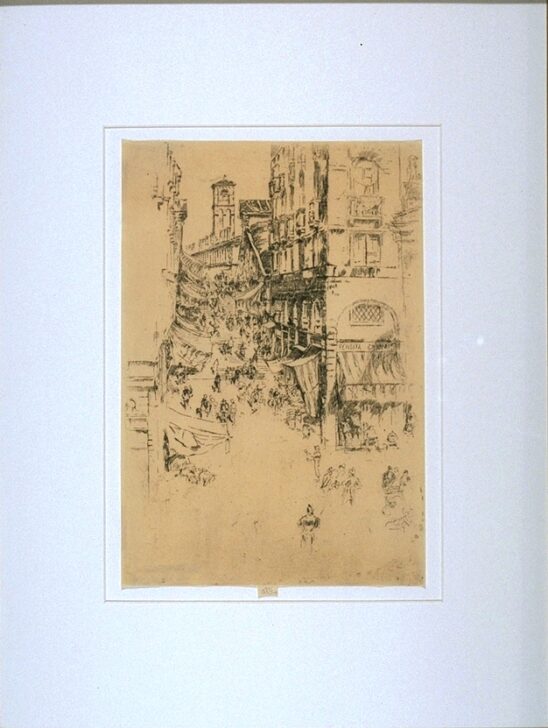The Rialto, from the “Second Venice Set,” or the “Twenty-six Etchings”
James Abbott McNeill Whistler

Description
The Rialto, from Twenty-six Etchings, or the
Second Venice Set
1879–80
Etching
First state of two (Kennedy 211)
Gift of the Friends of the Museum of Art on the Occasion of Their Twenty-fifth Anniversary, 1993/2.3
One of Venice’s chief attractions is the large Rialto Bridge that spans the Grand Canal. In traditional views of the city by eighteenth-century painters and nineteenth-century photographers, the majestic bridge is depicted in classical symmetry with the canal. Whistler gives us an unexpected—and unrecognizable—view of the stairs ascending the bridge and the bell tower of San Giovanni Elemosinario on the opposite side, drawn from an elevated vantage point in a second-floor window. The buildings flanking the steps nearly fill the top of the plate and plate tone has been eschewed in order to diminish the sense of recession in depth, flattening the composition.
Subject Matter:
Whistler's choice for subjects while in Venice rarely included the major monuments, familiar through the work of artists from Canaletto and Guardi to Turner earlier in the century. Here, the famed Rialto Bridge that crosses the Grand Canal is not shown in its immediately recognizable view spanning the water, but from the side of the bridge, showing the stairs that allow pedestrians to cross the Grand Canal. This disoriented vantage point is further heightened by the elevated position that opens up an undescribed passage at the bottom of the image.
Whistler wrote to his mother from Venice saying how he had "discovered a Venice within Venice that others never seem to have perceived." This etching of Venice's most famous bridge illustrates Whistler's penchant for finding subjects along back canals and in otherwise unexplored views.
Physical Description:
The corner of a massive building with awnings on both sides is seen on the right side; it has arched windows above the street level windows and several stories with balconies above. To the left is a long sloping stairway with awnings projecting above the stairway. In the distance beyond the stairway can be see the tower of a church. Buildings at the far left of the composition are barely indicated. Pediestrians are visible throughout, adjacent to the buildings on either side as well as ascending the stairs.
Usage Rights:
If you are interested in using an image for a publication, please visit https://umma.umich.edu/request-image/ for more information and to fill out the online Image Rights and Reproductions Request Form.